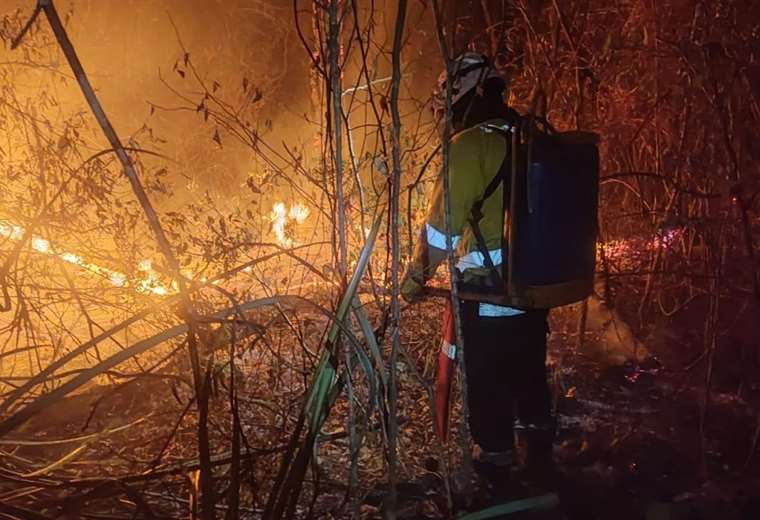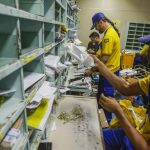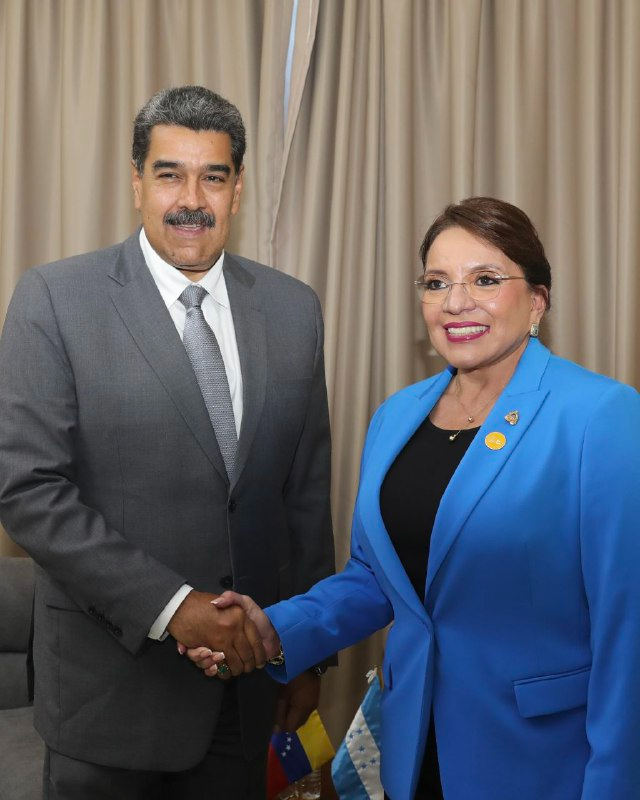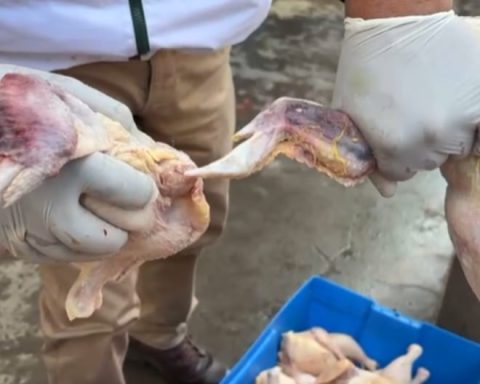“The heroic and selfless efforts of volunteer firefighters are of no use in the face of a structural problem. It is of no use to continue asking for expansion or drilling of water wells, because the one that generates that water, the forest, has disappeared. That is the underlying issue that they do not want to address. The forest is seen as a hindrance and not as an ally,” said Miguel Crespo, from Probioma, about the environmental crisis that Bolivia is going through.
“The forest cannot replace structural problems, such as unemployment,” said Alcides Vadillo, director of the Eastern Region of Fundación Tierra.
The devastation caused by forest fires is aggravated by drought, which in turn is aggravated by deforestation.
A report by the Friends of Nature Foundation (FAN), Swedish Cooperation and the European Union on changes in vegetation cover between 1956 and 2022 confirms that the issue deserves attention.
According to the document, Bolivia went from having more than 63 million hectares of forest to 55 million. Of the total deforested area in the country in those 66 years, 59% occurred in the last 22 years, from 2001 to 2022.
Departmental data
The report suggests that Santa Cruz is the department most concerned about accelerated forest loss, despite its environmental importance, as it is where almost half of the country’s forests are located, 46%.
Of the total loss of national vegetation cover, Santa Cruz accounts for 79% of the damage, with climatic impacts affecting mainly the agricultural sector, with multi-million dollar losses due to the recurrence of droughts and floods.
At the departmental level, 20% of Santa Cruz forests have disappeared in the period analyzed.
The second department listed is Beni, 6% of the country’s deforestation occurs in this department.
Deforestation in Cochabamba, La Paz, Pando, Tarija and Chuquisaca together represents 15% of the country’s total. And although Cochabamba and Tarija do not have a large deforested area on a national scale, both departments have already eliminated 11% and 8% of their original forest.
Deforestation rate
Before 2000, deforestation in Bolivia was below 188 thousand ha/year. Subsequently, on average, it fluctuated up to 191 thousand ha/year until 2010. The five-year period 2016-2020 marked the acceleration of deforestation in the country, exceeding 260 thousand ha/year; and in the short period 2021-2022, the increase in deforestation reached a historic record, 105% more than the average (192,892 ha/year) of the vice-period 2001-2020 (20 years), fluctuating around 396 thousand ha/year.
The report states that the deforestation rate in Santa Cruz is a determining factor for the entire country, and warns that in 1992, deforestation reached 132,000 hectares, compared to previous years, when it remained below 104,000 hectares/year.
The statistical graphs highlight that deforestation peaks were recorded in 1996, 2008, 2011, 2015, and 2021-2022. Although the document does not say so, these milestones coincide with the implementation of laws 1715 INRA and 1700 Forestry, the arrival of Evo Morales to the Government, the Sembrando por Bolivia Summit, and the return to power with Luis Arce Catacora.
Municipal scale
The document confirms that more than 50% of the country’s deforestation is concentrated in just ten municipalities, located in Santa Cruz. Of these, Pailón is the municipality with the greatest damage, representing a loss of 70% of its forest cover.
San Julián and Cuatro Cañadas have eliminated 88% and 90% of the forests within their boundaries. In San Ignacio de Velasco, annual deforestation ranged between 2,017 and 9,605 hectares between 1997 and 2006; it subsequently accelerated, and between 2017 and 2022 there was a considerable increase, between 225% and 546% more than what has occurred historically.
Other major areas affected include Charagua, San Jose de Chiquitos and Concepcion.
Protected areas
The research also concluded that the annual dynamics of deforestation in protected areas accelerated in 2008, 2016, 2017, and increased substantially in 2021 and 2022.
In nationally managed protected areas, the highest annual deforestation was 11,014 hectares in 2022, almost double the figure in 2017 (6,509 ha). Similarly, in subnationally managed protected areas, deforestation accelerated from 2016 (12,925 ha), doubling to 24,371 hectares in 2022.
Of the 23 protected areas under national management, 18 have been identified as having deforestation until 2022 (185,638 ha in total). Amboró National Park is the protected area with the highest deforestation, especially in 2022, while in Isiboro Sécure (TIPNIS), the greatest damage was in 2017. In Carrasco, the highest deforestation occurred in 2022. In San Matías and Iñao, the highest clearings were in 2022. In Madidi, 2020 was the worst year.
In 2017, then-Vice President Álvaro García Linera said that protected areas were “an invention of the gringos,” and that at some point they would enter those reserves to carry out hydrocarbon exploration. That same year, he requested the repeal of the law creating the departmental protected areas of Santa Cruz, a ruling that was only issued in 2023, and which has been taken up by the current Vice President, David Choquehuanca.
Regarding subnational protected areas, Bolivia has 159 reserves by 2022. The report detected deforestation in 102 areas, representing 64%. The last twelve years (2011-2022) account for 50% of the deforestation that has occurred within these areas, with a notable acceleration in 2016-2020, and with a tendency to increase in 2021-2022, which already represent 67% of the figure for the previous period.
Among the fifteen subnational protected areas with the most deforestation are Laguna Concepción, Río Grande and Valles Cruceños, Güendá Urubó, Yacuma, Rhukanrhuka, Ñembi Guasu, San Lorenzo Mountain Range, Copaibo, El Porvenir Forest, Santa Cruz La Vieja, Sararenda Mountain Range, Northern Wetlands, Los Milagros Mountain Range, Iténez, and the Puerto Rico Amazon Forest.
Predation has also reached Ramsar sites, especially the Pantanal; and in indigenous territories, the most affected are Isoso, Guarayos, Consejo Tsimane, Monte Verde, Charagua Norte and Multiétnico 2.
Microcharacterization
Jorge Ávila, manager of the Bolivian Forestry Chamber (CFB), said that forest reserves, formerly concessions, have also suffered a dramatic reduction, going from 6 to just over 2 million hectares throughout the country, since the enactment of the Forestry Law 1700 in 1996.
And although he believes that several factors played a role, including fires and land invasions, he focused on microcharacterization.
“Possession is already entering the informal land market. And here comes the issue of micro-characterization. When the Land Use Plan Law (PLUS) was approved, the agricultural and peasant sectors found a point of agreement. They feel affected and consider it a threat to their growth that more than 33 or 37% of the territory of Santa Cruz is considered as forest production land,” explained Ávila.
He added that a category was included, BG, which means forests and livestock. “There, livestock farmers gain a little from forest lands, and under the argument that the PLUS scale is very high, they questioned whether the lands that were being declared as forests, as forest lands, could not be so. And that is when they created the term microcharacterization,” he explained.
Those properties, added the CFB manager, in which it is considered that the PLUS does not coincide with their capacity for major land use, can be subjected to microcharacterization studies to change the status of that portion of territory, “and convert it to livestock or agricultural use. So, the burned, deforested lands, of course, if one does a microcharacterization study, no forest will be found. In 90% of the cases, the concept of microcharacterization is being used in this way,” he referred to fires and clearings.
For Miguel Crespo, all this means shooting oneself in the foot, because it leads to socio-environmental disaster. “Either the production model is changed, these incendiary laws are repealed, or Bolivia will go into the abyss and nothing awaits it but an apocalyptic scenario, like the one we are already experiencing,” he warned.
EL DEBER asked for a version from the ABT, but they said they would respond today because they were responding to fires.


















